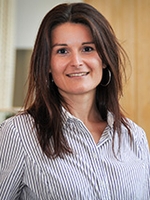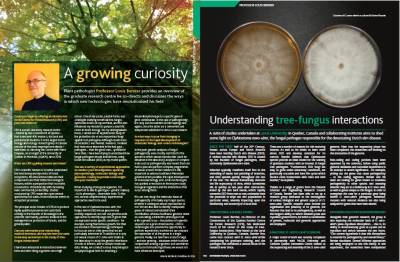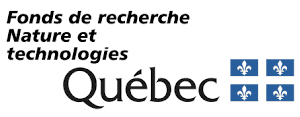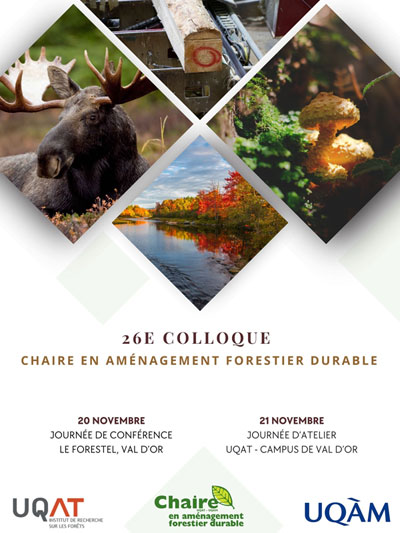
Louis Bernier
Membre régulier
Pathologie forestière
Professeur à la retraite
Université Laval
Faculté de foresterie, de géographie et de géomatique
Département des sciences du bois et de la forêt
Pavillon Charles-Eugène Marchand, local 2263
1030 avenue de la Médecine
Québec (Québec) Canada, G1V 0A6
(418) 656-7655
BIENVENUE DANS LA PAGE DU LABORATOIRE DE PATHOLOGIE FORESTIÈRE

FORMATION ACADÉMIQUE
- Postdoctorat en génétique microbienne, 1989 (Université Laval)
- Postdoctorat en biologie moléculaire des champignons, 1988 (Université de Bath, Royaume-Uni)
- Ph.D. en pathologie forestière, 1989 (Université de Toronto)
- M.Sc. en sciences forestières, 1983 (Université de Toronto)
- B.Sc. en génie forestier, 1981 (Université Laval)
Actualités phytopathologiques
2018
- Congrès et conférences sur invitation: Louis Bernier a été invité à présenter les résultats des travaux de l'équipe sur Ophiostoma novo-ulmi, tout d'abord en Corée du sud (Dankook University) et ensuite en Suède (Swedish Agricultural University, campus d'Alnarp). Il a également fait des présentations dans le cadre du congrès international de phytopathologie (ICPP2018)
 tenu à Boston, ainsi qu'à la conférence LIFE+ ELMIAS Ash and Elm
tenu à Boston, ainsi qu'à la conférence LIFE+ ELMIAS Ash and Elm  tenue en Suède.
tenue en Suède.
Un peu plus tôt cette année, Thais Campos de Oliveira et Jérôme Chapuis] avaient présenté l'avancement de leurs travaux sur la génomique fonctionnelle d'O. novo-ulmi lors de l'édition 2018 du Colloque annuel du CEF .
.
- Recrues: L’équipe accueille trois nouveaux membres qui travaillent sur les champignons. Dans le cadre d’un projet d’Initiation à la recherche, Marie Bourgault étudie le dimorphisme levure-mycélium chez les agents responsables de la maladie hollandaise de l'orme. Le Dr Jorge Luis Sarmiento Villamil s'intéresse pour sa part à la génomique fonctionnelle de ces mêmes agents, notamment aux gènes contribuant à leur pouvoir pathogène. Quant à Louis Paré, il s'intéresse plutôt aux champignons endomycorhiziens dans le cadre de son projet de maîtrise.
2017
- Diplômée:Martha Nigg a soutenu en juillet sa thèse de doctorat intitulée «Analyses transcriptomiques du dimorphisme levure-mycélium chez le champignon phytopathogène Ophiostoma novo-ulmi ». Martha mène présentement des travaux sur la génomique des insectes à l’Institut de Recherche pour le Développement (IRD) au Gabon.
- Distinctions: Marine Vautier a obtenu la première place au concours Science, Action
 du CRSNG qui consiste à vulgariser ses recherches en vidéo en 60 secondes. Je vous invite à visionner sa vidéo
du CRSNG qui consiste à vulgariser ses recherches en vidéo en 60 secondes. Je vous invite à visionner sa vidéo  .
.
- Le patron se recycle: J’ai profité d’une année d’étude et de recherche (AER) au sein de l’équipe de Philippe Silar
 à l’Université Paris Diderot (Paris 7) pour goûter aux joies de la génétique chez le champignon modèle Podospora anserina. Ce champignon coprophile a la particularité de compléter son cycle sexué très rapidement (5 à 7 jours) en laboratoire et de se prêter admirablement aux techniques telles le remplacement de gènes par intégration ciblée de marqueurs de sélection.
à l’Université Paris Diderot (Paris 7) pour goûter aux joies de la génétique chez le champignon modèle Podospora anserina. Ce champignon coprophile a la particularité de compléter son cycle sexué très rapidement (5 à 7 jours) en laboratoire et de se prêter admirablement aux techniques telles le remplacement de gènes par intégration ciblée de marqueurs de sélection.
- Recrues: Ce n’est pas parce que le patron est à l’étranger que le Laboratoire de pathologie forestière et de génomique des champignons s’arrête. Bien au contraire! Plusieurs recrues se sont jointes à l’équipe en 2017. Il s’agit de Thais Campos de Oliveira et de Jérôme Chapuis qui travailleront tous deux sur la génomique fonctionnelle d'Ophiostoma novo-ulmi. Pour sa part, Grace Sumampong étudiera les populations d'espèces fongiques appartenant au genre Heterobasidion responsables de la maladie du rond chez les conifères. Enfin, Jean-Guy Catford, responsable de travaux pratiques et de recherche avec une longue expérience en biochimie et en mycologie, vient prêter main-forte aux membres de l'équipe.
- Nouveau projet: Le projet de BioSurveillance des espèces exotiques envahissantes (BioSAFE) est lancé. Le financement obtenu de Génome Canada, Genome British Columbia et Génome Québec permettra d’étudier quatre ravageurs exotiques envahissants dont le champignon Ophiostoma novo-ulmi responsable de la pandémie actuelle de maladie hollandaise de l’orme. Vous pouvez en apprendre davantage en visitant le site web du projet
 .
.
THÈMES DE RECHERCHE
La pathologie forestière s’intéresse à l’étude des maladies chez les arbres. Les principales maladies sont causées par des facteurs abiotiques (gel, sécheresse, verglas, etc.) ou par des facteurs biotiques (notamment des microorganismes tels champignons, bactéries, virus, etc.). Bien que les arbres et les peuplements forestiers puissent également subir des dégâts importants dus aux insectes, ces derniers ne sont pas considérés comme étant des pathogènes et leur étude relève de l’entomologie. Comme c’est le cas pour plusieurs disciplines, l’étude des maladies des arbres revêt un côté pratique visant à répondre à des questions bien précises : quels sont les principaux agents pathogènes attaquant les arbres sur un territoire donné? Quel est l’impact de ces agents? Comment peut-on les contrôler ou, à tout le moins, minimiser les pertes dues à leur activité? Au-delà de ces considérations plus pratiques, l’étude des maladies biotiques résultant de l’interaction entre un hôte (arbre) et un agent pathogène permet également de mener des recherches de nature beaucoup plus fondamentale, par exemple sur l’écologie des agents pathogènes, ou encore sur la co-évolution entre ces derniers et leur hôte. Le thème central de mes activités de recherche est l’étude des microorganismes pathogènes des arbres. Pour ce faire, nous avons recours à différentes approches propres à la phytopathologie, à la biologie moléculaire et à la génomique. De façon générale, les travaux effectués par les membres de mon équipe se divisent en trois volets :
- identification des microorganismes associés à des maladies n’ayant pas (ou peu) été documentées;
- étude de la structure et de la dynamique des populations des agents pathogènes;
- identification de gènes contribuant à la pathogénie et à la valeur adaptative (fitness).
A ce sujet, vous pouvez lire cet article récent paru dans "International Innovation".
RÉALISATIONS RÉCENTES
Au fil des ans, nous avons étudié plusieurs espèces de champignons responsables de maladies chez les arbres ou de colorations dans l’aubier et les produits forestiers. Voici un aperçu des travaux en cours.
Identification de champignons associés à des essences forestières du Gabon et du Cameroun
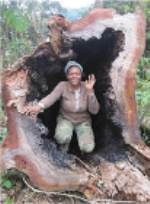
Dans le cadre du Projet d’appui à la formation en gestion des ressources naturelles dans le bassin du Congo ![]() , nous nous intéressons aux champignons causant des pathologies et des caries chez des essences forestières endémiques d’Afrique tropicale. La doctorante Ines Nelly Moussavou Boussougou fait appel au séquençage de gènes ADNr pour identifier les champignons responsables de caries et de pourridiés (maladies racinaires) chez Desbordia glaucescens, Scyphocephalium ochocoa et Paraberlinia bifoliata, trois essences faisant l’objet d’une exploitation commerciale au Gabon. Un autre doctorant, Joseph Djeugap Fovo, utilise la même approche pour identifier les champignons pathogènes du Ricinodendron heudelotii, une essence à fort potentiel agroforestier au Cameroun dont la domestication est cependant compliquée par des maladies affectant les différentes parties des plants.
, nous nous intéressons aux champignons causant des pathologies et des caries chez des essences forestières endémiques d’Afrique tropicale. La doctorante Ines Nelly Moussavou Boussougou fait appel au séquençage de gènes ADNr pour identifier les champignons responsables de caries et de pourridiés (maladies racinaires) chez Desbordia glaucescens, Scyphocephalium ochocoa et Paraberlinia bifoliata, trois essences faisant l’objet d’une exploitation commerciale au Gabon. Un autre doctorant, Joseph Djeugap Fovo, utilise la même approche pour identifier les champignons pathogènes du Ricinodendron heudelotii, une essence à fort potentiel agroforestier au Cameroun dont la domestication est cependant compliquée par des maladies affectant les différentes parties des plants.
Étude des champignons pathogènes des peupliers hybrides
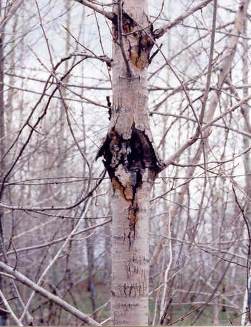
Photo: Patrick Filiatrault
Les peupliers hybrides sont particulièrement intéressants pour la foresterie québécoise, en raison notamment de leur croissance rapide sous nos conditions climatiques (vous trouverez plus d'information au Réseau Ligniculture Québec ![]() ). Le programme d’amélioration des peupliers hybrides en place au Québec, sous l’égide de la Direction de la recherche forestière du Ministère des Ressources naturelles et de la Faune, a déjà constitué un catalogue de clones bien adaptés aux différentes zones bioclimatiques de la province et résistants aux ravageurs et aux maladies, notamment le chancre septorien causé par le champignon Mycosphaerella populorum, ainsi que la rouille des feuilles causée par des champignons appartenant au genre Melampsora. Afin d’aider les améliorateurs dans leur travail pour obtenir une résistance durable, il importe de développer les connaissances sur les facteurs contribuant à la pathogénie chez les champignons précités, ainsi que les facteurs contribuant à la résistance chez les peupliers.
). Le programme d’amélioration des peupliers hybrides en place au Québec, sous l’égide de la Direction de la recherche forestière du Ministère des Ressources naturelles et de la Faune, a déjà constitué un catalogue de clones bien adaptés aux différentes zones bioclimatiques de la province et résistants aux ravageurs et aux maladies, notamment le chancre septorien causé par le champignon Mycosphaerella populorum, ainsi que la rouille des feuilles causée par des champignons appartenant au genre Melampsora. Afin d’aider les améliorateurs dans leur travail pour obtenir une résistance durable, il importe de développer les connaissances sur les facteurs contribuant à la pathogénie chez les champignons précités, ainsi que les facteurs contribuant à la résistance chez les peupliers.
Les travaux en cours sur le M. populorum visent à développer un système de transformation génétique pour la production de mutants chez ce champignon. Ces travaux ont été réalisés par Lauriane Varain dans le cadre d’un projet de maîtrise. L’obtention de ces mutants facilitera l’étude de la biologie du M. populorum. Par exemple, des mutants moins agressifs à l’endroit des peupliers permettraient d’identifier, chez M. populorum, des gènes contrôlant la pathogénie. Pour sa part, la doctorante Marine Vautier s’intéresse tout particulièrement aux mécanismes de défense activés chez les peupliers en réponse à M. populorum ou encore aux espèces du genre Melampsora. Ces travaux sont menés en étroite collaboration avec les chercheurs Philippe Tanguay et Armand Séguin du Service canadien des forêts.
Génomique des agents de la maladie hollandaise de l’orme
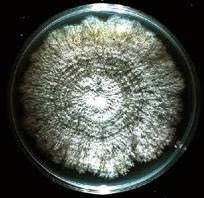
Les populations d’orme nord-américaines et européennes ont été décimées par deux pandémies successives, dont la plus récente est causée par le champignon ascomycète Ophiostoma novo-ulmi. Près d’un milliard d’ormes adultes ont été tués par ce parasite qui envahit les vaisseaux du xylème après y avoir été apporté par des vecteurs, en l’occurrence les scolytes de l’orme. Alors qu’on connaît bien le cycle de la maladie (appelée graphiose de l’orme, ou encore maladie hollandaise de l’orme - MHO), on ignore toujours comment O. novo-ulmi tue son hôte. L’identification formelle de facteurs contribuant à la pathogénie et à la valeur adaptative (fitness) chez ce champignon facilitera, à long terme, le développement de méthodes de lutte plus efficaces contre la MHO.
Nous utilisons des méthodes ponctuelles ciblant des gènes spécifiques, ainsi que des méthodes à haut débit permettant une analyse systématique des 8640 gènes que nous avons identifiés dans le génome d'O. novo-ulmi ![]() . Nous évaluons présentement la contribution de certains gènes à la fitness chez O. novo-ulmi. Pour ce faire, nous mesurons le pouvoir pathogène, la croissance et la reproduction chez des mutants produits en laboratoire. Nous nous intéressons également au dimorphisme levure-mycélium chez O. novo-ulmi qui, à l’instar de plusieurs autres champignons pathogènes des plantes ou des humains, a recours à deux modes de croissance lorsqu’il colonise son hôte. Nous croyons que la transition entre les modes de croissance unicellulaire (levuriforme) et multicellulaire (mycélienne) est un élément important de la pathogénie chez O. novo-ulmi. Les travaux des membres de l'équipe devraient nous en apprendre plus à ce sujet d’ici peu.
. Nous évaluons présentement la contribution de certains gènes à la fitness chez O. novo-ulmi. Pour ce faire, nous mesurons le pouvoir pathogène, la croissance et la reproduction chez des mutants produits en laboratoire. Nous nous intéressons également au dimorphisme levure-mycélium chez O. novo-ulmi qui, à l’instar de plusieurs autres champignons pathogènes des plantes ou des humains, a recours à deux modes de croissance lorsqu’il colonise son hôte. Nous croyons que la transition entre les modes de croissance unicellulaire (levuriforme) et multicellulaire (mycélienne) est un élément important de la pathogénie chez O. novo-ulmi. Les travaux des membres de l'équipe devraient nous en apprendre plus à ce sujet d’ici peu.
Nous participons activement au projet BioSAFE ![]() et collaborons également avec des collègues de l’University of Guelph et de l’Universidad Politécnica de Madrid à des travaux sur la réponse de l’orme à l’infection par O. novo-ulmi.
et collaborons également avec des collègues de l’University of Guelph et de l’Universidad Politécnica de Madrid à des travaux sur la réponse de l’orme à l’infection par O. novo-ulmi.
L'ÉQUIPE, VERSION 2010-2013
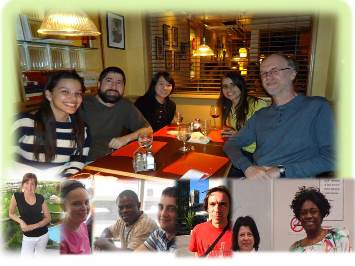
Montage photo: Erika Sayuri Naruzawa
DISTINCTIONS REÇUES
- 2002 Gordon J. Green Outstanding Young Scientist Award, Société canadienne de phytopathologie
- 2008 Hommage René-Pomerleau "Pionnier et Force vive de la pathologie forestière et moléculaire", Société de protection des plantes du Québec
Vous pouvez télécharger toutes mes références bibliographiques en format BibTeX, BibTeX-CSV, FRQNT ou EndNote
PUBLICATIONS
Livres
Aucun
Chapitres de livre
- Bernier, L. (2022) Dutch elm disease. (Chap. 25) In Forest Microbiology: Volume 2: Forest Tree Health. (Asiegbu, F. and A. Kovalchuk, Eds.) Elsevier, pages 291-309
- Bernier, L., Smith, S.M. (2015) Pests and Pathogens in North American Forest Ecosystems. (Chap. 16) In Routledge Handbook of Forest Ecology. (Peh, K.S.-H., Corlett, R.T. and Bergeron, Y., Eds.) Routledge, Oxford, UK
- Bernier, L. (2013) Towards Ophiostoma Genomics (Chap. 21). In CBS Biodiversity Series 12. The Ophiostomatoid Fungi: Expanding Frontiers. (Seifert, K.A., de Beer, Z.W. and Wingfield, M.J., Eds.) Utrecht, pages 235-242
- Massoumi Alamouti, S., Beaulieu, M.-E., Bernier, L., Breuil, C. (2013) Ophiostomatoid associates of spruce-infesting bark beetles in North America (Chap. 10). In CBS Biodiversity Series 12. The Ophiostomatoid Fungi: Expanding Frontiers. (Seifert, K.A., de Beer, Z.W. and & Wingfield, M.J., Eds.) Utrecht, pages 119-130
- Dewar, K., Bernier, L., Levesque, R.C. (1996) Electrophoretic karyotyping in fungi. (Chap. 2) In Nonmammalian Genomic Analysis: A Practical Guide. (Birren, B. and Lai, E., Eds.) San Diego, CA, USA, Academic Press, pages 25-60
- Bernier, L. (1993) Conventional and molecular genetic approaches to the study of pathogenicity in Ophiostoma ulmi sensu lato. (Chap. 22) In Dutch Elm Disease Research: Cellular and Molecular Approaches. (Sticklen, M.B. and Sherald, J.L., Eds.) New-York, USA, Springer-Verlag, pages 293-307
Livres, numéros spéciaux et actes de colloques publiés à titre d'éditeur
Aucun
Articles révisés par un comité de lecture
- de Oliveira, T.C., Freyria, N.J., Sarmiento-Villamil, J.L., Porth, I., Tanguay, P., Bernier, L. (2024) Unraveling the transcriptional features and gene expression networks of pathogenic and saprotrophic Ophiostoma species during the infection of Ulmus americana. Microbiology Spectrum
- Moslehi, M., Bernier, L., Zakeri, O., Ahmadi, A. (2024) First report of Streblote solitaria (Lepidoptera: Lasiocampidae) damage on Avicennia marina trees in southern mangroves of Iran. Ecological Frontiers, 44(2):359-364
- Sumampong, G., Feau, N., Bernier, L., Hamelin, R.C., Liu, J.-J., Shamoun, S.F. (2024) Genome sequence of Heterobasidion occidentale, a fungus that causes annosus root and butt rot among conifer trees in North America. Microbiology Resource Announcements
- Tanguay, P., Benoit, N., Potvin, A., Bernier, L. (2024) Development of a qPCR Assay for the Detection and Quantification of the Fungal Pathogen Calonectria canadiana on Conifers. Forest Pathology, 54(5):e12885
- Fijarczyk, A., Bernier, L., Sakalidis, M.L., Medina-Mora, C.M., Porth, I. (2023) Independent Evolution Has Led to Distinct Genomic Signatures in Dutch Elm Disease-Causing Fungi and Other Vascular Wilts-Causing Fungal Pathogens. Journal of Fungi, 9
- Martin, J.A., Dominguez, J., Solla, A., Brasier, C.M., Webber, J.F., Santini, A., Martinez-Arias, C., Bernier, L., Gil, L. (2023) Complexities underlying the breeding and deployment of Dutch elm disease resistant elms. New Forests, 54(4):661 – 696
- Islam, M.T., Coutin, J.F., Shukla, M., Dhaliwal, A.K., Nigg, M., Bernier, L., Sherif, S.M., Saxena, P.K. (2022) Deciphering the Genome-Wide Transcriptomic Changes during Interactions of Resistant and Susceptible Genotypes of American Elm with Ophiostoma novo-ulmi. Journal of Fungi, 8(2)
- Nigg, M., de Oliveira, T.C., Sarmiento-Villamil, J.L., de la Bastide, P.Y., Hintz, W.E., Sherif, S.M., Shukla, M., Bernier, L., Saxena, P.K. (2022) Comparative Analysis of Transcriptomes of Ophiostoma novo-ulmi ssp. americana Colonizing Resistant or Sensitive Genotypes of American Elm. Journal of Fungi, 8(6)
- Pare, L., Banchini, C., Hamel, C., Bernier, L., Stefani, F. (2022) A simple and low-cost technique to initiate single-spore cultures of arbuscular mycorrhizal fungi using a superabsorbent polymer. Symbiosis
- Pare, L., Banchini, C., Hamel, C., Bernier, L., Stefani, F. (2022) Correction: A simple and low-cost technique to initiate single-spore cultures of arbuscular mycorrhizal fungi using a superabsorbent polymer (Symbiosis, (2022), 88, 1-3, (61-73), 10.1007/s13199-022-00878-5). Symbiosis, 88(1-3):79
- Sarmiento-Villamil, J.L., Campos de Oliveira, T., Naruzawa, E.S., Bernier, L. (2021) An Efficient Strategy for Obtaining Mutants by Targeted Gene Deletion in Ophiostoma novo-ulmi. Frontiers in Microbiology, 12:1933
- Martin, J.A., Dominguez, J., Solla, A., Brasier, C.M., Webber, J.F., Santini, A., Martinez-Arias, C., Bernier, L., Gil, L. (2021) Complexities underlying the breeding and deployment of Dutch elm disease resistant elms. New Forests
- Hessenauer, P., Fijarczyk, A., Martin, H., Prunier, J., Charron, G., Chapuis, J., Bernier, L., Tanguay, P., Hamelin, R.C., Landry, C.R. (2020) Hybridization and introgression drive genome evolution of Dutch elm disease pathogens. Nature Ecology & Evolution
- DesRochers, P., Nadeau-Thibodeau, N., Bernier, L., Rioux, D. (2020) Reaction to release treatments and distinctive attributes of butternut that promote resistance to the canker caused by Ophiognomonia clavigignenti-juglandacearum. Forestry Chronicle, 96(02):130-140
- Et-Touil, A., Dusabenyagasani, M., Bouvet, G., Brasier, C., Bernier, L. (2019) Ophiostoma ulmi DNA naturally introgressed into an isolate of Ophiostoma novo-ulmi is clustered around pathogenicity and mating type loci. Phytoprotection, 99(1):1-11
- Rioux, D., Blais, M., Nadeau-Thibodeau, N., Lagace, M., DesRochers, P., Klimaszewska, K., Bernier, L. (2018) First Extensive Microscopic Study of Butternut Defense Mechanisms Following Inoculation with the Canker Pathogen Ophiognomonia clavigignenti-juglandacearum Reveals Compartmentalization of Tissue Damage. Phytopathology, 108(11):1237-1252
- Nigg, M., Bernier, L. (2017) Large-scale genomic analyses of in vitro yeast-mycelium dimorphism in human, insect and plant pathogenic fungi: From ESTs to RNAseq experiments. Fungal Biology Reviews, 31(3):131 - 142
- Djeugap Fovo, J., Dostaler, D., Bernier, L. (2017) Influence of Culture Media and Temperature on Growth and Sporulation of Lasiodiplodia theobromae, Pestalotiopsis microspora and Fusarium oxysporum Isolated from Ricinodendron heudelotii in Cameroon. International Journal of Current Microbiology and Applied Sciences, 6(6):3098-3112
- Naruzawa, E.S., Malagnac, F., Bernier, L. (2016) Effect of linoleic acid on reproduction and yeast–mycelium dimorphism in the Dutch elm disease pathogens. Botany, 94(1):31-39
- Sherif, S. M., Shukla, M. R., Murch, S. J., Bernier, L., Saxena, P. K. (2016) Simultaneous induction of jasmonic acid and disease-responsive genes signifies tolerance of American elm to Dutch elm disease. Scientific Reports, 6:21934-
- Djeugap, F.J, Bernier, L., Dostaler, D., Zena, D.R.G. (2016) First report of Lasiodiplodia theobromae causing shoot blight of Ricinodendron heudelotii seedlings in Cameroon. International Journal of Agronomy and Agricultural Research, 8:59-63
- Wedge, M.-E., Naruzawa, E.S., Nigg, M., Bernier, L. (2016) Diversity in yeast-mycelium dimorphism response of the dutch elm disease pathogens: The inoculum size effect. Canadian Journal of Microbiology, 62(6):525-529
- Bernier, L. (2016) Genome-wide analysis of parasitic fitness traits in a non-model tree pathogen. Canadian Journal of Plant Pathology, 38(2):153-163
- Comeau, A.M., Vincent, W.F., Bernier, L., Lovejoy, C. (2016) Novel chytrid lineages dominate fungal sequences in diverse marine and freshwater habitats. Scientific Reports, 6:30120-
- Nigg, M., Bernier, L. (2016) From yeast to hypha: defining transcriptomic signatures of the morphological switch in the dimorphic fungal pathogen Ophiostoma novo-ulmi. BMC Genomics, 17(1):920
- Bernier, L., Aoun, M., Bouvet, G.F., Comeau, A.M., Dufour, J., Naruzawa, E.S., Nigg, M., Plourde K.V. (2015) Genomics of the Dutch elm disease pathosystem: are we there yet? iForest - Biogeosciences and Forestry, 8(2):149-157
- Comeau, A.M., Dufour, J., Bouvet, G.F., Jacobi, V., Nigg, M., Henrissat, B., Laroche, J., Levesque, R.C., Bernier, L. (2015) Functional Annotation of the Ophiostoma novo-ulmi Genome: Insights into the Phytopathogenicity of the Fungal Agent of Dutch Elm Disease. Genome Biology and Evolution, 7(2):410-430
- Dhillon, B., Feau, N., Aerts, A.L., Beauseigle, S., Bernier, L., Copeland, A., Foster, A., Gill, N., Henrissat, B., Herath, P. et al. (2015) Horizontal gene transfer and gene dosage drives adaptation to wood colonization in a tree pathogen. Proceedings of the National Academy of Sciences of the United States of America, 112(11):3451-3456
- Nigg, M., Laroche, J., Landry, C.R., Bernier, L. (2015) RNAseq Analysis Highlights Specific Transcriptome Signatures of Yeast and Mycelial Growth Phases in the Dutch Elm Disease Fungus Ophiostoma novo-ulmi. G3: Genes|Genomes|Genetics, 5(11):2487-2495
- Djeugap, F.J., Bernier, L., Dostaler, D., Zena, D.R.G. (2015) Chemical Control of Shoot Blight [Lasiodiplodia theobromae (Pat.) Griffon & Maubl.] Infecting Ricinodendron heudelotii Seedlings in Cameroon. International Journal of Current Research in Biosciences and Plant Biology, 2:82-87
- Plourde, K.V., Bernier, L. (2014) A rapid virulence assay for the Dutch elm disease fungus Ophiostoma novo-ulmi by inoculation of apple (Malus × domestica ‘Golden Delicious’) fruits. Plant Pathology, 63(5):1078-1085
- Naruzawa, E.S., Bernier, L. (2014) Control of yeast-mycelium dimorphism in vitro in Dutch elm disease fungi by manipulation of specific external stimuli. Fungal Biology, 118(11):872 - 884
- Djeugap, F.J., Bernier, L., Dostaler, D., Fontem, D.A., Avana, M.L. (2014) Germination constraints on Ricinodendron heudelotii in Cameroon. Seed Technology, 36:61-72
- Vialle, A., Feau, N., Frey, P., Bernier, L., Hamelin, R.C. (2013) Phylogenetic species recognition reveals host-specific lineages among poplar rust fungi. Molecular Phylogenetics and Evolution, 66(3):628-644
- Forgetta, V., Leveque, G., Dias, J., Grove, D., Lyons Jr., R., Genik, S., Wright, C., Singh, S., Peterson, N., Zianni, M. et al. (2013) Sequencing of the Dutch Elm Disease Fungus Genome Using the Roche/454 GS-FLX Titanium System in a Comparison of Multiple Genomics Core Facilities. Journal of Biomolecular Techniques, 24(2):39-49
- Djeugap Fovo, J., Bernier, L., Dostaler, D., Khasa, D.P., Fontem, D.A., Nwaga, D. (2013) Opportunités et contraintes agroforestières de Ricinodendron heudelotii au Cameroun. International Journal of Biological and Chemical Sciences, 7:344-355
- Cacas, J.-L., Petitot, A.-S., Bernier, L., Estevan, J., Conejero, G., Mongrand, S., Fernandez, D. (2011) Identification and characterization of the Non-race specific Disease Resistance 1 (NDR1) orthologous protein in coffee. BMC Plant Biology, 11(1):144
- Hintz, W., Pinchback, M., de la Bastide, P., Burgess, S., Jacobi, V., Hamelin, R., Breuil, C., Bernier, L. (2011) Functional categorization of unique expressed sequence tags obtained from the yeast-like growth phase of the elm pathogen Ophiostoma novo-ulmi. BMC Genomics, 12(1):431
- Vialle, A., Frey, P., Hambleton, S., Bernier, L., Hamelin, R. (2011) Poplar rust systematics and refinement of Melampsora species delineation. Fungal Diversity, 50(1):227-248
- Jacobi, V., Dufour, J., Bouvet, G.F., Aoun, M., Bernier, L. (2010) Identification of transcripts up-regulated in asexual and sexual fruiting bodies of the Dutch elm disease pathogen Ophiostoma novo-ulmi. Canadian Journal of Microbiology, 56(8):697-705
- Aoun, M., Jacobi, V., Boyle, B., Bernier, L. (2010) Identification and monitoring of Ulmus americana transcripts during in vitro interactions with the Dutch elm disease pathogen Ophiostoma novo-ulmi. Physiological and Molecular Plant Pathology, 74(3-4):254-266
- Feau, N., Mottet, M.-J., Perinet, P., Hamelin, R.C., Bernier, L. (2010) Recent advances related to poplar leaf spot and canker caused by Septoria musiva. Canadian Journal of Plant Pathology, 32(2):122-134
- Aoun, M., Rioux, D., Simard, M., Bernier, L. (2009) Fungal Colonization and Host Defense Reactions in Ulmus americana Callus Cultures Inoculated with Ophiostoma novo-ulmi. Phytopathology, 99(6):642-650
- Temple, B., Bernier, L., Hintz, W.E. (2009) Characterisation of the polygalacturonase gene of the Dutch elm disease pathogen Ophiostoma novo-ulmi. New Zealand Journal of Forestry Science, 39(1):29-37
- Germain, H., Bergeron, M.-J., Bernier, L., Laflamme, G., Hamelin, R.C. (2009) Patterns of colonization and spread in the fungal spruce pathogen Onnia tomentosa. Molecular Ecology, 18(21):4422-4433
- LeBoldus, J.M., Blenis, P.V., Thomas, B.R., Feau, N., Bernier, L. (2009) Susceptibility of Populus balsamifera to Septoria musiva: A Field Study and Greenhouse Experiment. Plant Disease, 93(11):1146-1150
- Stanosz, G., Smith, D., Bernier, L. (2009) First report of Erysiphe palczewskii powdery mildew of Siberian pea tree (Caranga arborescens) in Wisconsin and Quebec. Plant Disease, 93(12):1352
- Bouvet, G.F., Jacobi, V., Plourde, K.V., Bernier, L. (2008) Stress-induced mobility of OPHIO1 and OPHIO2, DNA transposons of the Dutch elm disease fungi. Fungal Genetics and Biology, 45(4):565-578
- Plourde, K., Jacobi, V., Bernier, L. (2008) Use of insertional mutagenesis to tag putative parasitic fitness genes in the Dutch elm disease fungus Ophiostoma novo-ulmi subsp. novo-ulmi. Canadian Journal of Microbiology, 54(9):797-802
- Morin, C., Couturier, S., Bernier, L. (2007) Pathogenicity of wild-type and albino strains of the fungus Ceratocystis resinifera, a potential biocontrol agent against bluestain. Canadian Journal of Forest Research, 37(5):919-930
- Bouvet, G.F., Jacobi, V., Bernier, L. (2007) Characterization of three DNA transposons in the Dutch elm disease fungi and evidence of repeat-induced point (RIP) mutations. Fungal Genetics and Biology, 44(5):430-443
- Feau, N., Hamelin, R., Bernier, L. (2007) Variability of Nuclear SSU-rDNA Group Introns Within Septoria Species: Incongruence with Host Sequence Phylogenies. Journal of Molecular Evolution, 64(5):489-499
- Vujanovic, V., Hamelin, R. C., Bernier, L., Vujanovic, G., St-Arnaud, M. (2007) Fungal diversity, dominance, and community structure in the rhizosphere of clonal Picea mariana plants throughout nursery production chronosequences. Microbial Ecology, 54(4):672-684
- Bourassa, M., Bernier, L., Hamelin, R.C. (2007) Genetic Diversity in Poplar Leaf Rust (Melampsora medusae f. sp. deltoidae) in the Zones of Host Sympatry and Allopatry. Phytopathology, 97(5):603-610
- Tanguay, P., Loppnau, P., Morin, C., Bernier, L., Breuil, C. (2006) A spontaneous albino mutant of Ceratocystis resinifera results from a point mutation in the polyketide synthase gene, PKS1. Canadian Journal of Microbiology, 52(6):501-507
- Feau, N., Jacobi, V., Hamelin, R.C., Bernier, L. (2006) Screening of ESTs from Septoria musiva (teleomorph Mycosphaerella populorum) for detection of SSR and PCR-RFLP markers. Molecular Ecology Notes, 6(2):356-358
- Feau, N., Hamelin, R.C., Bernier, L. (2006) Attributes and congruence of three molecular data sets: Inferring phylogenies among Septoria-related species from woody perennial plants. Molecular Phylogenetics and Evolution, 40(3):808-829
- Morin, C., Tanguay, P., Breuil, C., Yang, D.Q., Bernier, L. (2006) Bioprotection of spruce logs against sapstain using an albino strain of Ceratocystis resinifera. Phytopathology, 96(5):526-533
- Et-Touil, A., Rioux, D., Mathieu, F.M., Bernier, L. (2005) External symptoms and histopathological changes following inoculation of elms putatively resistant to Dutch elm disease with genetically close strains of Ophiostoma. Canadian Journal of Botany, 83(6):656-667
- Bourassa, M., Bernier, L., Hamelin, R.C. (2005) Direct genotyping of the poplar leaf rust fungus, Melampsora medusae f. sp deltoidae, using codominant PCR-SSCP markers. Forest Pathology, 35(4):245-261
- Feau, N., Weiland, J.E., Stanosz, G.R., Bernier, L. (2005) Specific and sensitive PCR-based detection of Septoria musiva, S-populicola and S-populi, the causes of leaf spot and stem canker on poplars. Mycological Research, 109:1015-1028
- Feau, N., Hamelin, R.C., Vandecasteele, C., Stanosz, G.R., Bernier, L. (2005) Genetic structure of Mycosphaerella populoram (Anamorph Septoria musiva) Populations in north-central and northeastern north America. Phytopathology, 95(6):608-616
- Ouellette, G.B., Cherif, M., Simard, M., Bernier, L. (2005) Histopathology of Fusarium wilt of staghorn sumac (Rhus typhina) caused by Fusarium oxysporum f. s.p. callistephi race 3. I. Modes of tissue colonization and pathogen peculiarities. Phytoprotection, 86(3):157-174
- Filion, M., Hamelin, R.C., Bernier, L., St-Arnaud, M. (2004) Molecular profiling of rhizosphere microbial communities associated with healthy and diseased black spruce (Picea mariana) seedlings grown in a nursery. Applied and Environmental Microbiology, 70(6):3541-3551
- Morin, C., Breuil, C., Bernier, L. (2004) Genetic variability and structure of Canadian populations of the sapstain fungus Ceratocystis resinifera. Phytopathology, 94(12):1323-1330
- Bernier, L. (2004) Genomics of ophiostomatoid fungi: the first two thousand genes. Phytoprotection, 85(1):39-43
- Feau, N., Bernier, L. (2004) First report of shining willow as a host plant for Septoria musiva. Plant Disease, 88(7):770-770
- Gargouri, S., Bernier, L., Hajlaoui, M.R., Marrakchi, M. (2003) Genetic variability and population structure of the wheat foot rot fungus, Fusarium culmorum, in Tunisia. European Journal of Plant Pathology, 109(8):807-815
- Tanguay, P., Coupal, J., Bernier, L. (2003) Genetic transformation, electrophoretic karyotyping and isolation of insertional mutants in the tree pathogenic fungus Neonectria galligena. Forest Pathology, 33(6):413-428
- Tadesse, Y., Bernier, L., Hintz, W.E., Horgen, P.A. (2003) Real time RT-PCR quantification and Northern analysis of cerato-ulmin (CU) gene transcription in different strains of the phytopathogens Ophiostoma ulmi and O. novo-ulmi. Molecular Genetics and Genomics, 269(6):789-796
- Germain, H., Laflamme, G., Bernier, L., Boulet, B., Hamelin, R.C. (2002) DNA polymorphism and molecular diagnosis in Inonotus spp. Canadian Journal of Plant Pathology, 24(2):194-199
- Reyes, I., Bernier, L., Antoun, H. (2002) Rock phosphate solubilization and colonization of maize rhizosphere by wild and genetically modified strains of Penicillium rugulosum. Microbial Ecology, 44(1):39-48
- Plante, F., Hamelin, R.C., Bernier, L. (2002) A comparative study of genetic diversity of populations of Nectria galligena and N-coccinea var. faginata in North America. Mycological Research, 106:183-193
- Kabore, B.K., Couture, L., Dostaler, D., Bernier, L. (2001) Variabilité phénétique du Colletotrichum graminicola du sorgho. Canadian Journal of Plant Pathology, 23(2):138-145
- Cheng, Y., Belzile, F., Tanguay, P., Bernier, L., Belanger, R. (2001) Establishment of a gene transfer system for Pseudozyma flocculosa, an antagonistic fungus of powdery mildew fungi. Molecular Genetics and Genomics, V266(1):96-102
- Gagne, P., Yang, D.Q., Hamelin, R.C., Bernier, L. (2001) Genetic Variability of Canadian Populations of the Sapstain Fungus Ophiostoma piceae. Phytopathology, 91(4):369-376
- Reyes, I., Baziramakenga, R., Bernier, L., Antoun, H. (2001) Solubilization of phosphate rocks and minerals by a wild-type strain and two UV-induced mutants of Penicillium rugulosum. Soil Biology and Biochemistry, 33(12-13):1741-1747
- Ouellette, G.B., Rioux, D., Bussieres, G., Simard, M., Bernier, L. (2000) Extracellular sheath formation by Sphaeropsis hypodermia and association with its infection in elm trees. Phytoprotection, 81(2):69-86
- Gosselin, L., Jobidon, R., Bernier, L. (1999) Biological Control of Stump Sprouting of Broadleaf Species in Rights-of-Way with Chondrostereum purpureum: Incidence of the Disease on Nontarget Hosts. Biological Control, 16:60-67
- Uzunovic, A., Yang, D.Q., Gagne, P., Breuil, C., Bernier, L., Byrne, A., Gignac, M., Kim, S.H. (1999) Fungi that cause sapstain in Canadian softwoods. Canadian Journal of Microbiology, 45:914–922
- Reyes, I., Bernier, L., Simard, R.R., Tanguay, P., Antoun, H. (1999) Characteristics of phosphate solubilization by an isolate of a tropical Penicillium rugulosum and two UV-induced mutants. FEMS Microbiology Ecology, 28(3):291-295
- Reyes, I., Bernier, L., Simard, R.R., Antoun, H. (1999) Effect of nitrogen source on the solubilization of different inorganic phosphates by an isolate of Penicillium rugulosum and two UV-induced mutants. FEMS Microbiology Ecology, 28(3):281-290
- Yang, D.Q., Gagne, P., Uzunovic, A., Gignac, M., Bernier, L. (1999) Development of fungal stain in logs of three Canadian softwoods. Forest Products Journal, 49(2):39-42
- Gosselin, L., Jobidon, R., Bernier, L. (1999) Genetic variability and structure of Canadian populations of Chondrostereum purpureum, a potential biophytocide. Molecular Ecology, 8(1):113-122
- Et-Touil, A., Brasier, C.M., Bernier, L. (1999) Localization of a pathogenicity gene in Ophiostoma novo-ulmi and evidence that it may be introgressed from O-ulmi. Molecular Plant-Microbe Interactions, 12(1):6-15
- Et-touil, K., Bernier, L., Beaulieu, J., Berube, J.A., Hopkin, A., Hamelin, R.C. (1999) Genetic Structure of Cronartium ribicola Populations in Eastern Canada. Phytopathology, 89(10):915-919
- Dewar, K., Bousquet, J., Dufour, J., Bernier, L. (1997) A meiotically reproducible chromosome length polymorphism in the ascomycete fungus Ophiostoma ulmi (sensu lato). Molecular and General Genetics, 255(1):38-44
- Plante, F., Bernier, L. (1997) Variability of virulence of Nectria galligena towards northern hardwoods. European Journal of Forest Pathology, 27(4):261-272
- Temple, B., Horgen, P.A., Bernier, L., Hintz, W.E. (1997) Cerato-ulmin, a hydrophobin secreted by the causal agents of Dutch elm disease, is a parasitic fitness factor. Fungal Genetics and Biology, 22(1):39-53
- Gosselin, L., Jobidon, R., Bernier, L. (1996) Assessment of genetic variation within Chondrostereum purpureum from Quebec by random amplified polymorphic DNA analysis. Mycological Research, 100:151-158
- Yang, D.Q., Bernier, L. (1996) Production and use of calli from yellow birch buds for in vitro assessment of virulence of Nectria galligena isolates. Plant Cell, Tissue and Organ Culture, 45(2):175-177
- Bernier, L., Yang, D., Ouellette, G.B., Dessureault, M. (1996) Assessment of Phaeotheca dimorphospora for biological control of the Dutch elm disease pathogens, Ophiostoma ulmi and O. novo-ulmi doi:10.1046/j.1365-3059.1996.d01-161.x. Plant Pathology, 45(4):609-617
- Yang, D.Q., Bernier, L., Dessureault, M. (1995) Phaeotheca dimorphospora increases Trichoderma harzianum density in soil and suppresses red pine damping-off caused by Cylindrocladium scoparium. Canadian Journal of Botany, 73(5):693-700
- Yang, D.Q., Laflamme, G., Bernier, L., Dessureault, M. (1995) Phaeotheca dimorphospora as a potential biocontrol agent for shoot blight caused by Gremmeniella abietina. Canadian Journal of Plant Pathology, 17(1):7-12
- Dewar, K., Bernier, L. (1995) Inheritance of chromosome-length polymorphisms in Ophiostoma ulmi (sensu lato). Current Genetics, 27(6):541-549
- Bernier, L., Hamelin, R.C., Ouellette, G.B. (1994) Comparison of ribosomal DNA length and restriction site polymorphisms in Gremmeniella and Ascocalyx isolates. Applied and Environmental Microbiology, 60(4):1279-1286
- Bernier, L., Hubbes, M. (1994) Induction and genetic characterization of ultraviolet-sensitive mutants in the elm tree pathogen Ophiostoma ulmi(sensu lato). Mycological Research, 98:943-953
- Yang, D.Q., Bernier, L., Dessureault, M. (1994) Biological control of Septoria leaf spot of poplar by Phaeotheca dimorphospora. Plant Disease, 78(8):821-825
- Yang, D.Q., Plante, F., Bernier, L., Piche, Y., Dessureault, M., Laflamme, G., Ouellette, G.B. (1993) Evaluation of a Fungal Antagonist, Phaeotheca-Dimorphospora, for Biological-Control of Tree Diseases. Canadian Journal of Botany, 71(3):426-433
- Dewar, K., Bernier, L. (1993) Electrophoretic karyotypes of the elm tree pathogen Ophiostoma ulmi (sensu lato). Molecular Genetics and Genomics, 238(1):43-48
- Hamelin, R.C., Ouellette, G.B., Bernier, L. (1993) Identification of Gremmeniella abietina Races with Random Amplified Polymorphic DNA Markers. Applied and Environmental Microbiology, 59(6):1752-1755
- Bernier, L., Hubbes, M. (1990) Mutations in Ophiostoma ulmi induced by N-methyl-N'-nitro-N-nitrosoguanidine. Canadian Journal of Botany, 68(2):225-231
- Bernier, L., Hubbes, M. (1990) Meiotic analysis of induced mutations in Ophiostoma ulmi. Canadian Journal of Botany, 68(2):232-235
- Bernier, L., Cooper, R.M., Charnley, A.K., Clarkson, J.M. (1989) Transformation of the entomopathogenic fungus Metarhizium anisopliae to benomyl resistance doi:10.1111/j.1574-6968.1989.tb03483.x. FEMS Microbiology Letters, 60(3):261-266
- Jeng, R.S., Bernier, L., Brasier, C.M. (1988) A comparative study of cultural and electrophoretic characteristics of the Eurasian and North American races of Ophiostoma ulmi. Canadian Journal of Botany, 66(7):1325-1333
- Bernier, L., Jeng, R.S., Hubbes, M. (1983) Differentiation of aggressive and non-aggressive strains of Ceratocystis ulmi by polyacrylamide gel electrophoresis of intramycelial enzymes. Mycotaxon, 17:456–72
Articles publiés dans des actes de colloque (proceedings)
- Villamil, J.L.S., Campos de Oliveira, T., Naruzawa, E. S., Bernier, L. (2019) An efficient strategy for obtaining mutants by targeted gene deletion in Ophiostoma novo-ulmi. In Molecular Plant-Microbe Interactions. 3340 Pilot Knob Road, St Paul, MN 55121 USA, October. Amer Phytopathological Soc, page 120
- Bernier, L. (2017) Genome-wide analyses of the Dutch elm disease fungi. In Proceedings of the American elm restoration workshop 2016: 2016 October 25-27. Lewis Center, OH. Gen. Tech. Rep. NRS-P-174. Newtown Square, PA. (Knight, Kathleen S.; Haugen, Linda M.; Flower, Charles E.; Slavicek, James M., Eds.) Pages 6-20
- Tsui, C.K.M., Alamouti, S.M., Bernier, L., Bohlmann, J., Breuil, C., Hamelin, R.C. (2009) Population structure of Grosmannia clavigera, a pine pathogen associated with mountain pine beetle. In Canadian Journal of Plant Pathology. January. Canadian Phytopathological Soc, pages 139-139
- Aoun, M., Jacobi, V., Boyle, B., Rioux, D., Simard, M., Bernier, L. (2009) Identification and profiling of American elm genes involved in a compatible interaction with the fungal pathogen Ophiostoma novo-ulmi. In Proceedings of the XIV MPMI Congress. Quebec (QC), Canada. (Antoun, H., Avis, T.J., Brisson, L., Prevost, D. and Trepanier, M., Eds.)
- Plourde, K.V., Jacobi, V., Bernier, L. (2008) Recovery and functional analysis of six contiguous genes that may affect parasitic fitness in the Dutch elm disease fungus Ophiostoma novo-ulmi. In Phytopathology. June, S126-S126
- Morin, C., Bernier, L. (2007) Protection biologique du bois contre le bleuissement à l’aide d’une souche albinos du champignon de bleuissement Ceratocystis resinifera. In Actes du colloque sur la lutte biologique et intégrée Protéger la forêt…naturellement. (Ressources naturelles Canada, Eds.) Pages 64-67
- Bernier, L. (2006) Structural and Functional Genomics of Dutch Elm Disease Fungi. In Genomics for future forests. First Canadian forest genomics symposium. Ottawa. (Bonfils, A.-C., Gamache, I., Eds.) Natural Resources Canada, Canadian Forest Service, Headquarters, pages 57-60
- Bernier, L. (2004) Génomique des champignons ophiostomatoïdes : un gène, c’est bien; deux, c’est mieux; deux mille, c’est encore mieux! In Phytoprotection. (Societe de protection des plantes du Quebec, Eds.) Pages 40-43
- Bernier, L., Breuil, C., Hintz, W.E., Horgen, P.A., Jacobi, V., Dufour, J., Aoun, M., Bouvet, G., Kim, S.H., Diguistini, S. et al. (2004) The Canadian Ophiostoma Genome Project. In Investigación agraria. Sistemas y recursos forestales. Pages 105-117
- Messier, C., Bigue, B., Bernier, L. (2003) Using fast-growing plantations to promote forest ecosystem protection in Canada. In Forest management at the XII World Forestry Congress. (FAO, Unasylva, Eds.) Pages 59-63
- Bernier, L., Feau, N., Gagne, P., Mottet, M.J., Perinet, P., Hamelin, R.C. (2003) L’établissement et la protection des plantations. In Actes Colloques du Carrefour de la recherche forestière. Quebec
- Bernier, L., Plante, F., Plante, D., Tanguay, P., Camy, C. (1998) Pathogenic variability of Nectria galligena. In Foliage, Shoot and Stem Diseases in Forest Trees. Canadian Forest Service, Quebec. (Laflamme, G., Berube, J.A., Hamelin, R.C., Eds.) Pages 140-149
- Bernier, L., Hamelin, R.C., Lecours, N., Ouellette, G.B. (1995) Use of nucleic acid and isoenzyme polymorphisms for taxonomic and population studies of Gremmeniella spp. In Shoot and Foliage Diseases in Forest Trees. Florence, Italy. (Capretti, P., Heiniger, U., Stephan, R., Eds.) Pages 198-203
Rapports scientifiques, manuels et autres
Aucun
Thèses, mémoires et essais
- Bernier, L. (1989) Induction, characterization and mapping of mutations in Ophiostoma ulmi, the causal agent of Dutch elm disease. Thèse de doctorat, Faculty of Forestry, University of Toronto
- Bernier, L. (1983) Relationships between isoenzymes, cultural characters, and pathogenicity in Ceratocystis ulmi (Buism.) C. Moreau. Mémoire de maîtrise, Faculty of Forestry, University of Toronto
Thèses, mémoires et essais supervisés
- Pare, L. (2022) Évaluation d'un polymère superabsorbant pour la culture des champignons mycorhiziens arbusculaires sur substrat transparent non stérile. Mémoire de maîtrise, Université Laval
- Moussavou, I.N. (2021) Les champignons endophytes et ceux associés aux caries des arbres et du bois mort de Julbernardia bifoliolata, Desbordesia glaucescens et Scyphocephalium ochocoa dans les forêts du Sud-est du Gabon. Thèse de doctorat, Université Laval
- Ponchart, J. (2019) Explorative metabarcoding of Abies balsamea L. Mill. endomycobiota. Thèse de doctorat, Université Laval
- Nigg, M. (2017) Analyses transcriptomiques du dimorphisme levure-mycélium chez le champignon phytopathogène Ophiostoma novo-ulmi. Thèse de doctorat, Université Laval
- Naruzawa, E. S. (2015) Bases moléculaires du dimorphisme levure-mycélium chez le champignon phytopathogène Ophiostoma novo-ulmi. Thèse de doctorat, Université Laval
- Nadeau-Thibodeau, N. (2015) Le chancre causé par l’Ophiognomonia clavigignenti-juglandacearum : protection et rétablissement du noyer cendré. Mémoire de maîtrise, Université Laval
- Varain, L. (2013) Transformation avec la bactérie Agrobacterium tumefaciens de deux Ascomycètes Septoria musiva et Septoria populicola, agents phytopathogènes du peuplier. Mémoire de maîtrise, Université Laval
- Djeugap Fovo, Joseph (2013) Contraintes de germination et diagnostic moléculaire des champignons associés aux maladies chez Ricinodendron heudelotii au Cameroun. Thèse de doctorat, Université Laval
- Vialle, A. (2011) Entre code-barres génétiques et reconnaisance phylogénétique, clarification de la systématique des espèces responsables de la rouille du peuplier (Melampsora spp). Thèse de doctorat, Université Laval
- Plourde, K. (2010) L'utilisation de la mutagénèse insertionnelle afin d'identifier des gènes procurant un avantage parasitaire au champignon "Ophiostoma novo-ulmi subsp. novo-ulmi", agent de la maladie hollandaise de l'orme. Thèse de doctorat, Université Laval
- Aoun, M. (2009) Une analyse histopathologique et génomique d'une interaction in vitro entre Ulmus americana et Ophiostoma novo-ulmi. Thèse de doctorat, Université Laval
- Bouvet, G. (2007) Caractérisations et impacts des transposons à ADN chez Ophiostoma ulmi et O. novo-ulmi, principaux agents de la maladie hollandaise de l'orme. Thèse de doctorat, Université Laval
- Beaulieu, M.-E. (2007) Caractérisation moléculaire des champignons ophiostomatoïdes associés à quatre espèces de scolytes de l'écorce colonisant l'épinette blanche au Québec et phylogénie multigénique d'une nouvelle espèce de Leptographium. Mémoire de maîtrise, Université Laval
- Morin, C. (2006) Étude du potentiel d'une souche albinos de Ceratocystis resinifera pour la protection biologique du bois contre le bleuissement. Thèse de doctorat, Université Laval
- Feau, N. (2005) Relations intra et interspécifiques chez Mycosphaerella populorum (anamorphe septoria musiva) agent pathogène des peupliers. Thèse de doctorat, Université Laval
- Joly, D. (2005) Analyse de la diversité génomique des populations de Cronartium ribicola, agent responsable de la rouille vésiculeuse du pin blanc. Mémoire de maîtrise, Université Laval
- Majeau, J.-A. (2005) Identification de séquences génomiques avoisinant un gène impliqué dans la pathogénécité et protéines candidates pouvant être codées par cette région, chez le champignon Ophiostoma novo-ulmi. Mémoire de maîtrise, Université Laval
- Allaire, M. (2005) Diversité fonctionnelle des Pseudomonas producteurs d'antibiotiques dans les rhizosphères de conifères en pépinières et en milieu naturel. Mémoire de maîtrise, Université Laval
- St-Michel, E. (2004) Identification et analyse de marqueurs génétiques diagnostiques de deux champignons de rouille des pins durs (Cronartium comptoniae et Peridermium harknessii) et identification d'un hyperparasite de ces rouilles au Québec. Mémoire de maîtrise, Université Laval
- Grondin, J. (2004) Effet de phytohormones sur les réactions de défense de l'érable à sucre (Acer saccharum Marsh.) suite à l'entaillage et à d'autres types de blessure mécanique. Mémoire de maîtrise, Université Laval
- Cloutier, M. (2003) Caractérisation de la protéine kinase PNek1 et de la 14-3-3 P20-5 chez le peuplier. Thèse de doctorat, Université Laval
- Plante, F. (2001) Génétique de populations du champignon pathogène Nectria galligena dans le nord-est de l'Amérique du nord. Thèse de doctorat, Université Laval
- Germain, H. (2001) Étude moléculaire du champignon phytopathogène Ionotus tomentosus. Mémoire de maîtrise, Université Laval
- Okamba Ondzia, F. R. (2001) Diversité génétique des locus codants et structure génétique des populations du Cronartium ribicola nord-américaines. Mémoire de maîtrise, Université Laval
- Bourassa, M. (2000) Épidémiologie moléculaire d'un champignon causant la rouille des feuilles du peuplier, Melampsora medusae f. sp deltoidae, en Amérique du Nord. Mémoire de maîtrise, Université Laval
- Et-Touil, A. (2000) Étude génétique, biochimique et physiologique de la pathogénécité chez Ophiostoma novo-ulmi. Mémoire de maîtrise, Université Laval
- Tanguay, P. (1999) Transformation génétique et détermination du caryotype électrophorétique du champignon phytopathogène Nectria galligena. Mémoire de maîtrise, Université Laval
- Gagne, P. (1999) Variabilité génétique chez Ophiostoma piceae, agent de coloration de l'aubier, au Canada. Mémoire de maîtrise, Université Laval
- Reyes, I. (1998) Dissolution des phosphates minéraux par le champignon tropical Penicillium rugulosum : mécanismes d'action. Thèse de doctorat, Université Laval
- Et-Touil, K. (1998) Structure génétique des populations du Cronartium ribicola canadiennes. Mémoire de maîtrise, Université Laval
- Goulet, A. (1998) Épidémiologie du champignon Chondrostereum purpureum, agent de maîtrise biologique de la reproduction végétative des feuillus de lumière en milieu forestier = Epidemiology of the fungus Chondrosterum purpureum, a biological control agent of the asexual reproduction of deciduous tree species in forest environment. Mémoire de maîtrise, Université Laval
- Moungid, Z. (1998) Phæotheca dimorphospora : approche d'isolement et étude phylogénétique. Mémoire de maîtrise, Université Laval
- Kabore, K.B. (1997) Variabilité du Colletotrichum graminicola chez le sorgho (Sorghum bicolor) et lutte culturale contre l'anthracnose. Thèse de doctorat, Université Laval
- Gosselin, L. (1996) Maîtrise biologique de la reproduction végétative chez des feuillus, dispersion et variabilité génétique de l'agent microbien impliqué, Chondrostereum purpureum. Thèse de doctorat, Université Laval
- Dewar, K. (1995) Physical characterization of genome structure in Ophiostoma ulmi (Sensu lato). Thèse de doctorat, Université Laval
- Plante, D. (1995) Analyse génétique et biochimique de la virulence chez Nectria galligena. Mémoire de maîtrise, Université Laval
Articles non révisés par un comité de lecture
- Cogliastro, A., Bouchard, A., Domon, G., Bernier, L. (2008) Les hauts et les bas de la forêt feuillue : sommes-nous prêts pour un nouveau changement de paysage? Options politiques, 29:58-61
<< Yves Bergeron | MembresReguliers | Olivier Blarquez >>





